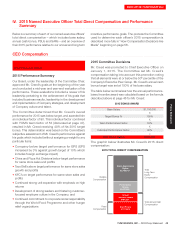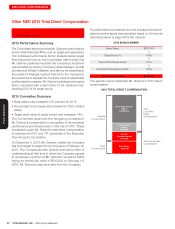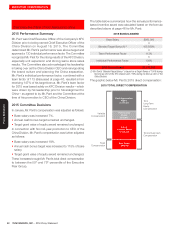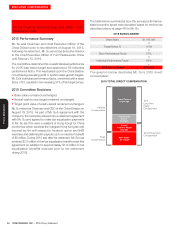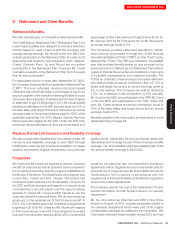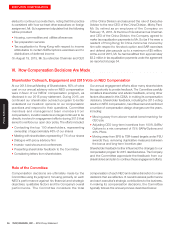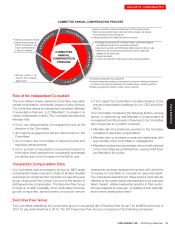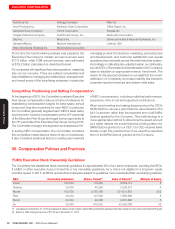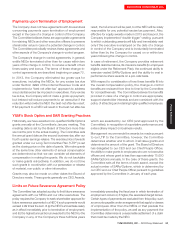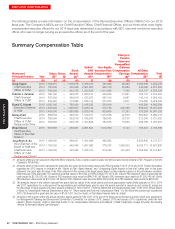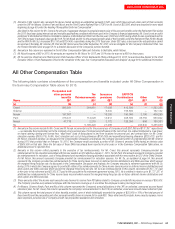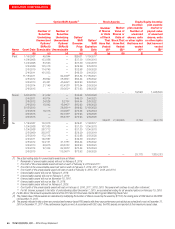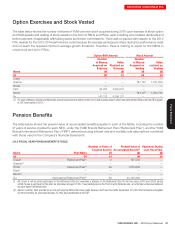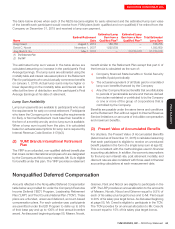Pizza Hut 2015 Annual Report Download - page 73
Download and view the complete annual report
Please find page 73 of the 2015 Pizza Hut annual report below. You can navigate through the pages in the report by either clicking on the pages listed below, or by using the keyword search tool below to find specific information within the annual report.
YUM! BRANDS, INC.-2016Proxy Statement 59
Proxy Statement
EXECUTIVE COMPENSATION
Payments upon Termination of Employment
The Company does not have agreements with its executives
concerning payments upon termination of employment
except in the case of a change in control of the Company.
The Committee believes these are appropriate agreements
for retaining NEOs and other executive officers to preserve
shareholder value in case of a potential change in control.
The Committee periodically reviews these agreements and
other aspects of the Company’s change-in-control program.
The Company’s change-in-control agreements, in general,
entitle NEOs terminated other than for cause within two
years of the change in control, to receive a benefit of two
times salary and bonus. The terms of these change-in-
control agreements are described beginning on page 72.
In 2013, the Company eliminated tax gross-ups for
executives, including the NEOs, for any excise tax due
under Section 4999 of the Internal Revenue Code and
implemented a “best net after-tax” approach to address
any potential excise tax imposed on executives. If any excise
tax is due, the Company will not make a gross-up payment,
but instead will reduce payments to an executive if the
reduction will provide the NEO the best net after-tax result.
If full payment to a NEO will result in the best net after-tax
result, the full amount will be paid, but the NEO will be solely
responsible for any potential excise tax payment. Also,
effective for equity awards made in 2013 and beyond, the
Company implemented “double trigger” vesting, pursuant
to which outstanding awards will fully and immediately vest
only if the executive is employed on the date of a change
in control of the Company and is involuntarily terminated
(other than by the Company for cause) on or within two
years following the change in control.
In case of retirement, the Company provides retirement
benefits described above, life insurance benefits (toemployees
eligible under the Retirement Plan), the continued ability to
exercise vested SARs/Options and the ability to vest in
performance share awards on a pro-rata basis.
With respect to consideration of how these benefits fit into
the overall compensation policy, the change-in-control
benefits are reviewed from time to time by the Committee
for competitiveness. The Committee believes the benefits
provided in case of a change in control are appropriate,
support shareholder interests and are consistent with the
policy of attracting and retaining highly qualified employees.
YUM’s Stock Option and SAR Granting Practices
Historically, we have awarded non-qualified SARs/Options
grants annually at the Committee’s January meeting. This
meeting date is set by the Board of Directors more than
sixmonths prior to the actual meeting. The Committee sets
the annual grant date as the second business day after our
fourth quarter earnings release. The exercise price of awards
granted under our Long-Term Incentive Plan (“LTIP”) is set
as the closing price on the date of grants. We make grants
at the same time other elements of annual compensation
are determined so that we can consider all elements of
compensation in making the grants. We do not backdate
or make grants retroactively. In addition, we do not time
such grants in coordination with our possession or release
of material, non-public or other information.
Grants may also be made on other dates the Board of
Directors meets. These grants generally are CEO Awards,
which are awarded by our CEO (and approved by the
Committee), in recognition of superlative performance and
extraordinary impact on business results.
Management recommends the awards be made pursuant
to our LTIP to the Committee, however, the Committee
determines whether and to whom it will issue grants and
determines the amount of the grant. The Board of Directors
has delegated to our CEO and our Chief People Officer,
the ability to make grants to employees who are not executive
officers and whose grant is less than approximately 15,000
SARs/Options annually. In the case of these grants, the
Committee sets all the terms of each award, except the
actual number of SARs/Options, which is determined by
our CEO and our Chief People Officer pursuant to guidelines
approved by the Committee in January of eachyear.
Limits on Future Severance Agreement Policy
The Committee has adopted a policy to limit future severance
agreements with our NEOs and our other executives. The
policy requires the Company to seek shareholder approval for
future severance payments to a NEO if such payments would
exceed 2.99 times the sum of (a) the NEO’s annual base salary
as in effect immediately prior to termination of employment;
and (b) the highest annual bonus awarded to the NEO by the
Company in any of the Company’s three full fiscal years
immediately preceding the fiscal year in which termination of
employment occurs or, if higher, the executive’s target bonus.
Certain types of payments are excluded from this policy, such
as amounts payable under arrangements that apply to classes
of employees other than the NEOs or that predate the
implementation of the policy, as well as any payment the
Committee determines is a reasonable settlement of a claim
that could be made by the NEO.


